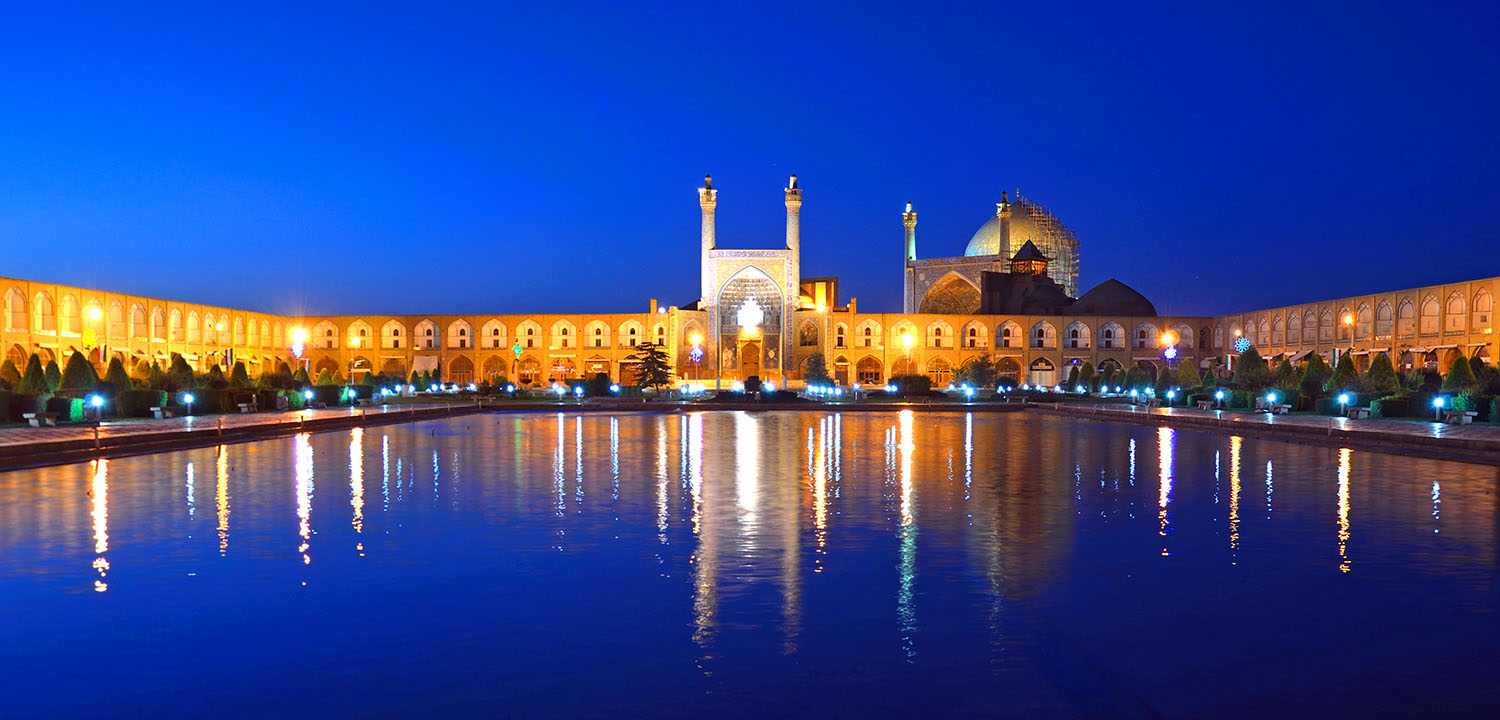In Isfahan, Naqsh-e Jahan Square, also known as Emam Square, is one of the most beautiful places in Isfahan City. Naqsh-e Jahan Square is the largest gathering of ancient monuments in this city. In its life, this beautiful square has gone through ups and downs and has been neglected by the rulers at different times, but it still has many admirers worldwide today. This square was included in the UNESCO World Heritage List because of its importance as an Iran tourism attraction.
This beautiful square in Isfahan City offers many sightseeing opportunities and historical monuments. This can be achieved by participating in tours of Isfahan or visiting Isfahan personally. Iran Travel Guide Center examines the historical sights of Emam Square at Isfahan in this article. Join us to learn more about how this historic square is unique.
About Naqsh-e Jahan Square
Naqsh-e Jahan Square is a prominent historical complex in Iran and the world. The beautiful square in Isfahan is visited by many tourists who visit the city to see its historical attractions. Before the revolution, Naqsh-e Jahan Square was called Shah Square, and afterward, Imam Square.
Throughout history, Emam Square at Isfahan has been called Grand Square, Main Square, New Square, Palace Square, and Royal Square. The square was once home to a beautiful garden known as Nahsh Jahan before the Safavid era.

This garden took its name from a city in Azerbaijan, which is now called Nakhchivan. The most glorious period of this square’s history was Shah Abbas Safavid’s reign. As Shah Abbas moved the capital from Qazvin to Isfahan, he constructed historical monuments, which led to prosperity and expansion in the market in this square. The newly built court was called the “New Square.” With the yard’s expansion during Shah Abbas II’s reign and its subsequent enlargement, the name of the new court was changed to Naqsh-e Jahan Square. Naqsh-e Jahan Square is more than 500 meters long and 160 meters wide. There are 200 rooms covered on two floors around the square and four historical monuments in different locations. Arches have been built around the court to protect the buildings, which have become modern shops.
The Sights of Emam Square at Isfahan
Naqsh-e Jahan Square has many historical effects, so if you don’t know them well, you may miss specific experiences. Following are some of the sights in this square that you can visit.
The general atmosphere of Naqsh-e Jahan Square
By entering the Naqsh-e Jahan Square, you enter a different city atmosphere. This square has a large pool in the middle of which the beauty of its fountain is famous in general and in particular. You can quickly move around the yard and enjoy its beauty thanks to its numerous passageways. Religious buildings and mosques are on both sides of the square, and a spectacular palace is on the opposite side.
The entrance of Isfahan Bazaar is from the same square that invites you to a historical and different world. Around the court, some stalls or shops sell pure handicrafts and dazzle you with their products. Everything is so unique and spectacular that you forget to step inside the building and want to see more. Perhaps that’s why there are stone benches in Naqsh-e Jahan Square to sit on and enjoy the life of the people in Isfahan for a moment.
Aali Qapu Palace | An irreplaceable manifestation of art
One of the most eye-catching buildings in Emam Square at Isfahan is the Aali Qapu Palace e, which is located on its western side and invites you to its inner world with a charming appearance. This mansion is 48 meters high and has six floors connected by spiral stairs.
It was constructed in the 16th century by Shah Abbas I after the transfer of the Safavid capital from Qazvin to Isfahan to serve as the seat and government of the Safavid sultans. Shah Abbas I, especially Shah Abbas II and Shah Suleiman, continued constructing the Aali Qapu Palace during five architectural stages. The most spectacular part of this palace is the plastering of the last floor, known as the music room or sound room, and the role of various instruments can be seen in it.
Sheikh Lotfollah Mosque: Spectacular Combination of Color and Light
The beautiful mosque dome stands out in the corner of this historic square because, unlike other mosques whose minarets have reached the sky, no minaret is visible above it. Sheikh Lotfollah Mosque is one of Isfahan’s most critical historical mosques, built in the Safavid period, and is now one of the most famous sights in the Naqsh-e Jahan Square Complex.
Emam Mosque, The Most Critical Historical Mosque of Isfahan
On the south side of the square, some domes and minarets belong to the Emam Mosque of Isfahan city. This is the most important historical mosque in Isfahan and one of Iran’s most important structures of Islamic architecture. It is also known as the Shah Mosque, Soltani Mosque, and Jame Mosque.
It is a unique masterpiece of architecture and tiling constructed by Shah Abbas the Great in the twenty-fourth year of his reign. The decorations and additions continued to be made until his successors lived. The beauty of the colors and the grandeur of the scene of this mosque create one of the most stunning images before your eyes. The repetition of elements, symmetrical arches, the large ablution pool, the tiles, etc., will awe you all.
Qeysarie Gate: A Gateway to Trade!
One of the structures from the Safavid era is the Qeysarie Gate, which is at the corner of Naqsh-e Jahan Square and the entrance to Isfahan Bazaar. The building once had three floors, but due to the destruction of one of the floors, there are only two floors left today.

Qeysarie Gate comprises four side doors, the main gate, and a pond. On top of the gate are paintings by Reza Abbasi. Isfahan’s Grand Bazaar, the beating heart of the city’s economy, is reached through this entrance.
Emam Square at Isfahan: Recreational Facilities
There are several entertainment venues, historical sites, numerous restaurants, and cafes around Naqsh-e Jahan Square. The square’s floor is paved, and cars cannot cross it. Thus, there is a place for tourists to walk and, of course, a carriage rides in the square. A unique atmosphere prevails when the square’s lights are turned on at sunset and in the afternoon. It will create happy memories for you because of the excellent weather and the light of the shops around it. If you visit Naghsh Jahan Square in Isfahan, you will have a memorable day and a happy time.




No comment